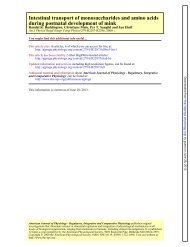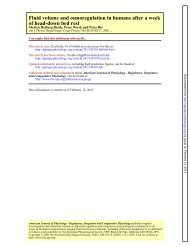Mechanical strain regulation of the Chicken glypican-4 gene ...
Mechanical strain regulation of the Chicken glypican-4 gene ...
Mechanical strain regulation of the Chicken glypican-4 gene ...
You also want an ePaper? Increase the reach of your titles
YUMPU automatically turns print PDFs into web optimized ePapers that Google loves.
LEGENDS TO FIGURES<br />
Fig. 1. The assembly <strong>of</strong> <strong>the</strong> PCR products <strong>of</strong> <strong>the</strong> chicken GPC-4.<br />
Fig. 2. Predicted amino acid sequence <strong>of</strong> <strong>the</strong> coding region <strong>of</strong> chicken GPC-4. Amino<br />
acids are denoted by <strong>the</strong> single-letter code. Gray background represents identity in <strong>the</strong><br />
amino acids between <strong>the</strong> chicken and <strong>the</strong> mammalian <strong>gene</strong>s. Open circles indicate cystein<br />
residues that are conserved in all GPC members. The N-terminal signal and C-terminal<br />
hydrophobic region are boxed. Glypican signature region is represented by a solid line.<br />
Fig.3. In situ hybridization <strong>of</strong> ESG biopsies, taken at various intervals after oviposition<br />
with <strong>the</strong> avian GPC-4 probe. (A) The egg resides in <strong>the</strong> isthmus; (B) 1 h, (C) 2 h, (D) 8 h,<br />
(E) 12 h and (F) 17 h after <strong>the</strong> entry <strong>of</strong> <strong>the</strong> egg into <strong>the</strong> ESG. Magnification 20x.<br />
Fig. 4. GPC-4 <strong>gene</strong> expression in <strong>the</strong> ESG. (A) Hematoxylin-Eosin staining. (B) In situ<br />
hybridization with chicken GPC-4 specific probe. PE - pseudostratified epi<strong>the</strong>lium, GE –<br />
glandular epi<strong>the</strong>lium.<br />
Fig 5. Effect <strong>of</strong> mechanical <strong>strain</strong> on GPC-4 <strong>gene</strong> expression in <strong>the</strong> ESG. <strong>Mechanical</strong><br />
<strong>strain</strong> was applied when <strong>the</strong>re were no egg in <strong>the</strong> ESG and <strong>the</strong> GPC-4 <strong>gene</strong> was not<br />
expressed. (A) Control, no <strong>strain</strong>; (B) 3 h after mechanical <strong>strain</strong> induction; inflated<br />
volume was 20 cm 3 , (C) 3 h after mechanical <strong>strain</strong> induction; inflated volume was 60<br />
cm 3 . Magnification 20x.<br />
Fig.6. Effect <strong>of</strong> mechanical <strong>strain</strong> withdrawal on GPC-4 <strong>gene</strong> expression. Premature<br />
forced oviposition was performed in order to remove <strong>the</strong> mechanical <strong>strain</strong> imposed by<br />
<strong>the</strong> resident egg at <strong>the</strong> time <strong>of</strong> maximal mechanical <strong>strain</strong> induction. (A) 2 h after<br />
expulsion <strong>of</strong> <strong>the</strong> egg from <strong>the</strong> ESG; (B) Control, <strong>the</strong> egg is in <strong>the</strong> ESG, 9 h after<br />
oviposition.<br />
19







